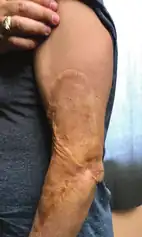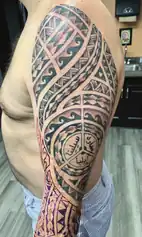Cover-up tattoo
A cover-up is a tattoo done over an unwanted past tattoo, scars (especially those resulting from surgery or self-harm), or symptoms of a skin condition. It is one of the two main options of removing an unwanted tattoo; the other option being laser removal. Covering up an unwanted tattoo is generally cheaper, less painful and an overall easier solution than tattoo removal.[1]: 104 A person may choose to get a cover-up over an older tattoo for aesthetic reasons, such as to enhance or replace a faded tattoo, or to erase an unwanted reminder. Numerous celebrities have employed tattoo artists to cover up existing tattoos, often after the breakup of a relationship. Some tattoo artists volunteer to cover hateful and gang-related tattoos with new designs for free.
.JPG.webp)
A decorative cover-up tattoo can obscure a scar or skin condition with personally meaningful art, sometimes as an alternative to a paramedical tattoo that would try to conceal or disguise the area in a naturalistic way. For example, in lieu of reconstruction post-mastectomy, a person may choose to get a decorative tattoo over their scars.
Contexts
Unwanted past tattoos

A person may seek a cover-up tattoo if they wish to distance themself from existing tattoos. The simplest reason is if the person is not aesthetically satisfied with how a tattoo appears on their body.[2] In particular, cover-ups are associated with regret for the original tattoo.[3][4] Tattoo artists who do cover-ups are commonly asked to cover tattoos related to a person's past relationship.[5]
As tattoos grew more mainstream in the 1990s and even more in the 2000s, celebrity tattoos received significant attention, especially cover-ups of couples tattoos after breakups.[6][7][8] Examples include Denise Richards, Pete Davidson and Angelina Jolie.[6] After breaking up with actress Winona Ryder in 1993, actor Johnny Depp partially covered up a "Winona Forever" tattoo, to read "Wino Forever".[9]
Popular culture in the 2010s included further growth in the popularity of tattoos and coverage of celebrity cover-up tattoos. In 2017, influencer Kylie Jenner had her "T" for rapper Tyga changed to "LA" after their breakup.[10] After marital separation in 2020, Nick Cannon replaced a large back tattoo of singer Mariah Carey's first name with a depiction of the crucifixion of Jesus.[11] Comedian Pete Davidson and singer Ariana Grande got a combined 16 tattoos relating to each other before breaking off their engagement in 2018,[12] then multiple cover-ups.[8][13][14][15]
Some sex trafficking victims who are subjected to branding tattoos later cover them up with chosen tattoos.[16]: 64 In the United States and Canada, organizations including Survivor's Ink[16]: 64 and Unbound[17] facilitate such cover-ups. People may also seek cover-ups of tattoos that represent hateful views or affiliation with criminal groups.[18][19][20][21]
Scars and skin conditions
The use of flesh-like medical tattoos to cover up skin conditions' symptoms and surgical scars is a long-established practice, dating to the German doctor Pauli in 1835, who used mercury sulfide and white lead to tattoo over skin lesions including nevi and purple plaque,[22]: 930 [23]: 368–369 or even to Galen, who executed tattoos of sorts over corneal opacities in 150 CE.[24]: 81
In the 21st century, decorative cover-up tattoos became a more popular approach to obscuring scars, including burns, self-harm scars, surgical scars, and stretch marks.[25]: 540–541 In cases of scars that are hyperpigmented, uneven in texture, or cover a large area, it is often not possible to restore the flesh's previous appearance; decorative tattoos serve to either cover or camouflage these scars instead.[26]: 5 A 2008 case report,[27] one of the first medical articles on the subject, noted patients taking the initiative in receiving decorative cover-ups.[26]: 5–6 Decorative tattoos in lieu of reconstruction post-mastectomy emerged as a trend in the early 2010s, particularly in the United States.[28] A 2021 systematic review speculated that decorative scar concealment is one of the most common applications of medical tattooing in a cosmetic or reconstructive context, but noted a lack of evidence, perhaps because many such tattoos happen at the patient's initiative rather than through a medical provider.[26]: 6–7
Similarly, it can be difficult to hide vitiligo with tattooed pigment, and so some people choose to get artistic tattoos as a distraction.[29] Tattoos are recommended only for people whose conditions are stable, as tattooing may itself trigger vitiligo.[30]: 763 In 2021, a research team developed a system to print customized temporary tattoos onto the bodies of children with vitiligo.[31]
For people with self-harm scars, cover-up tattoos can be a way of moving past trauma.[32][33] Public figures with self-harm cover-up tattoos include Paris Jackson[34] and Pete Davidson.[35] Self-harm cover-ups raise the complication that the pain of the tattoo process may trigger memories of self-harming.[32]
Methods
Technique

Covering a previous tattoo is more difficult than creating a fresh tattoo, so it requires skill and experience.[36] In cover-up tattoos, the previous tattoo has made the skin more sensitive and more passes of the needle are required, damaging the skin more than a first tattoo does.[37]: 34–35 This means the artist needs to be especially careful to work at the correct depth and with the right amount of color in the needle.[37]: 34–35
Poorly applied, faded, or light tattoos are the easiest to cover, especially tattoos that are at least several years old.[36] A person may choose to lighten a tattoo using laser removal before getting a cover-up design.[36]
When tattooing over scars, especially raised scars, it can be difficult for an artist to get the ink to stay in place.[36]
Design
A cover-up can modify an existing tattoo by adding details, colors, or new elements, or it can completely mask the old tattoo with a new design.[38] A colorful image with a lot of shading and shapes, such as animals or flowers, can offer more coverage than an image in black-and-gray style.[36]
A person may choose to completely cover an old tattoo with black ink with a simple boxy shape[38] or a "blackout" tattoo design.[39] Flesh tones are generally ineffective for cover-ups, as they lack the translucence of untattooed skin and are rarely able to cover up dark colors.[40]: 68
Cover-up designs will always be bigger in size compared to the previous design, as it helps to hide the design.[36] Some of the previous tattoo may still be partially visible to a person familiar with the original design.[36] Special photography techniques, including infrared photography, may also be able to detect the underlying tattoo design.[1][41]
Tattoo artist practices
Tattoo artists may offer discounted or complimentary sessions for cover-up tattoos. Some artists have gained note for doing so for sexual trafficking survivors.[17][42] Others do so for covering self-harm scars.[43][44] Tattooing on scarred skin may present complications, and some artists are averse to the practice. Canadian tattoo artist Becky Jónsson, who has cover-ups over their own dermatillomania scars and specializes in scarred skin, told CBC News in 2023 that many clients choose to continue with tattoos even if their tissue cannot hold ink to the desired degree.[32]
One tattoo shop in Kentucky, Unted States, which began offering free cover-ups of racist tattoos in the wake of the murder of George Floyd, received 20 requests in about a month.[18] Three months later, a different Kentucky shop with the same policy reported doing four to six cover-ups a week of racist tattoos, deferring excess demand to other shops, some of which requested donations to Black Lives Matter in lieu of payment.[19] In the U.S. state of Oklahoma, an annual event offers free cover-ups of hateful and gang-related tattoos, including those associated with Juggalo culture (due to the existence of Juggalo gangs).[20][21] However, the event's organizer notes that "Just because you hate your ex-wife, doesn’t make that a hate tattoo".[21]
Removal
A tattoo applied on top of another tattoo can make laser removal more challenging, because lasers target specific wavelengths, and in the same location there may be multiple pigments with different wavelengths.[45]
References
- Bryson, David; Wright, Jonathan; Barker, Kimberley (December 2013). "The identification of tattoo designs under cover-up tattoos using digital infrared photography". Journal of Visual Communication in Medicine. 36 (3–4): 104–110. doi:10.3109/17453054.2013.851654. PMID 24252142.
- King, Olivia (2023-08-21). "Ingenious Cover-Up Tattoos: Unveiling Tattooing's Underrated Artistry". Inked. Retrieved 2023-08-31.
- Preston, Devon (2018-11-12). "What to Do About Tattoo Regret". Inked. Retrieved 2023-08-31.
- Hopkins, A. R. (2023-07-26). "What To Expect When You Go For A Tattoo Coverup". Glam. Retrieved 2023-08-31.
- Davidson, Deborah (2016-12-15). The Tattoo Project: Commemorative Tattoos, Visual Culture, and the Digital Archive. Canadian Scholars. p. 81. ISBN 978-1-55130-945-3.
- Shaw, Gabbi. "22 times celebrities had to cover up their regrettable tattoos". Insider. Retrieved 2022-02-23.
- Lubitz, Rachel. "6 Celebrities Who Covered Up Their Tattoos After A Breakup". Refinery29. Vice Media. Retrieved 2023-08-30.
- Barron, Lee (2020). Tattoos and Popular Culture: Cultural Representations in Ink. SocietyNow. Emerald Publishing Limited. p. 155. ISBN 978-1-83909-218-3.
- VanHoose, Benjamin (2022-06-28). "Winona Ryder Describes Her Life in '90s Post Johnny Depp Split as 'My Girl, Interrupted Real Life'". People Magazine. Retrieved 2023-09-05.
- Fernández, Alexia (2017-07-04). "Kylie Jenner Unveils New Tattoo Replacing Lowercase 'T'". People. Retrieved 2023-08-30.
- Obell, Sylvia (2020-10-27). "Nick Cannon Covers Up 'Mariah' Tattoo in a Big Way". Essence. Retrieved 2023-08-30.
- Lubitz, Rachel. "16 Tattoos Later — What Will Happen To Ariana & Pete's Shared Ink?". Refinery29. Vice Media. Retrieved 2023-08-30.
- Henderson, Cydney. "Ouch! Pete Davidson covers up matching Ariana Grande tattoo with the word 'CURSED'". USA TODAY. Retrieved 2023-08-30.
- Chambers, Hannah (2019-02-11). "Pete Davidson Just Savagely Covered an Ariana Tattoo with the Word "Cursed"". Cosmopolitan. Retrieved 2023-08-30.
- Lubitz, Rachel. "Pete Davidson Has Officially Started Covering Up His Ariana-Inspired Ink". Refinery29. Vice Media. Retrieved 2023-08-30.
- Guo, Emily L.; Kream, Elizabeth; Merlo, Alisha; Friedman, Paul M. (January 2023). "Liberating more than light: Laser removal of branding tattoos is impactful in the recovery of sex trafficking survivors". Lasers in Surgery and Medicine. 55 (1): 61–66. doi:10.1002/lsm.23612. ISSN 0196-8092.
- Fiedler, Rebecca (2022-02-19). "Bryan tattoo artist creates cover-up pieces for branded survivors of human trafficking". 25 News KXXV and KRHD. Retrieved 2023-08-31.
- Harmon, Amy; Burch, Audra D. S. (2020-06-22). "White Americans Say They Are Waking Up to Racism. What Will It Add Up To?". The New York Times. ISSN 0362-4331. Retrieved 2023-08-30.
- Austin, Emma. "Kentucky tattoo shop is working to 'cover the hate' with free cover-ups of racist symbols". The Courier-Journal. Retrieved 2023-08-30.
- Slanchik, Amy (2023-02-21). ""Stop The Hate": Sand Springs Tattoo Parlor Helps More Than 100 People Cover Tattoos". News on 6. Retrieved 2023-08-31.
- Bishop-Baldwin, Sharon (2023-01-26). "Free tattoo coverup event to replace hate now in its sixth year: 'How can you quit that?'". Tulsa World. Retrieved 2023-08-31.
- Garg, Geeta; Thami, Gurvinder P. (August 2005). "Micropigmentation: Tattooing for Medical Purposes". Dermatologic Surgery. 31 (8): 928–931. doi:10.1097/00042728-200508000-00007.
- Vassileva, Snejina; Hristakieva, Evgeniya (July 2007). "Medical applications of tattooing". Clinics in Dermatology. 25 (4): 367–374. doi:10.1016/j.clindermatol.2007.05.014.
- Ziegler, SL (1922). "Multicolor Tattooing of the Cornea". Transactions of the American Ophthalmological Society. 20: 71–87. PMC 1318311. PMID 16692612.
- Moulton, Kieran Lane (7 February 2023). "Exploring tattoo artists' understanding of decorative non-medical professional tattooing as a method of scar camouflage and decoration". Psychology, Health & Medicine. 28 (2): 540–547. doi:10.1080/13548506.2022.2057556.
- Becker, Stacie J; Cassisi, Jeffrey E (1 September 2021). "Applications of Medical Tattooing: A Systematic Review of Patient Satisfaction Outcomes and Emerging Trends". Aesthetic Surgery Journal Open Forum. 3 (3). doi:10.1093/asjof/ojab015.
 This article incorporates text from this free content work. Licensed under CC-BY 4.0.
This article incorporates text from this free content work. Licensed under CC-BY 4.0. - Spyropoulou, G.A.; Fatah, F. (October 2009). "Decorative tattooing for scar camouflage: patient innovation". Journal of Plastic, Reconstructive & Aesthetic Surgery. 62 (10): e353–e355. doi:10.1016/j.bjps.2008.01.043.
- Locke, Katherine (7 August 2013). "Women choose body art over reconstruction after cancer battle". The Guardian. ISSN 0261-3077.
- Harris, John E. (2015-03-03). "Should someone with vitiligo get a tattoo?". "Speaking of Vitiligo" - UMass Chan Medical School. Retrieved 2023-09-02.
- Glassy, Crystal M.; Glassy, Matthew S.; Aldasouqi, Saleh (November 2012). "Tattooing: Medical uses and problems". Cleveland Clinic Journal of Medicine. 79 (11): 761–770. doi:10.3949/ccjm.79a.12016.
- Huang, Muling; Zhang, Lingyan; Liu, Lijuan; Zhu, Pinqi; Zhang, Chao; Sonchaeng, Pitchayapat; Ying, Weiqiang; Wang, Pinhao; Hu, Yuqi; Ying, Fangtian; Yao, Cheng (8 May 2021). "ColorGuardian: Customize Skin Tattoos for Children with Vitiligo" (PDF). CHI EA '21: Extended Abstracts of the 2021 CHI Conference on Human Factors in Computing Systems: 1–6. doi:10.1145/3411763.3451615 – via ResearchGate.
- Sharma, Anchal (2023-04-17). "Pain into Art: For Taneeta Taljit, tattooing over self-harm scars offers hope". CBC News. Video and photos by Adrienne Row-Smith. Retrieved 4 September 2023.
- Kapela, Kimberly. "'It was almost like closing a chapter in my life': A healing journey through tattooing". The Columbia Chronicle. Retrieved 4 September 2023.
- Martin, Anne. "Paris Jackson says tattoos cover scars from past 'self-hatred'". UPI. Retrieved 4 September 2023.
- Preston, Devon (25 February 2020). "Pete Davidson Opens Up About Self Harm and His Tattoos". Inked. Retrieved 4 September 2023.
- Massacre, Megan (2019-07-16). The Art of Tattoo: A Tattoo Artist's Inspirations, Designs, and Hard-Won Advice. Clarkson Potter/Ten Speed. pp. 212–214. ISBN 978-0-399-57878-6.
- Kristensen, Lars (24 March 2015). "The Technique and Craftsmanship of Tattooing in the Professional Tattoo Parlour". Current Problems in Dermatology. 48: 31–36. doi:10.1159/000369176.
- Miranda, Michelle D. (2015-09-10). Forensic Analysis of Tattoos and Tattoo Inks. CRC Press. pp. 65–67. ISBN 978-1-4987-3643-5.
- Cochrane, Lauren (2016-03-29). "Dark art: the rise of the blackout tattoo". The Guardian. Retrieved 2022-06-15.
- De Cuyper, Christa (2015). "Complications of Cosmetic Tattoos". Current Problems in Dermatology. 48: 61–70. doi:10.1159/000369188.
- Holz, F.; Birngruber, C. G.; Ramsthaler, F.; Verhoff, M. A. (2019-01-31). "Beneath cover-up tattoos: possibilities and limitations of various photographic techniques". International Journal of Legal Medicine. 134 (2): 697–701. doi:10.1007/s00414-019-02007-2. ISSN 1437-1596. PMID 30706194.
- Adamakos, Tess (2018-12-17). "Tattoo Parlor Gives Free Cover-Ups to Sex Trafficking Survivors". Inked. Retrieved 2023-08-31.
- Preston, Devon (2018-12-07). "Tattoo Artist Changes the Lives of People Who Self-Harm With Free Tattoos". Inked. Retrieved 2023-08-31.
- Gowdy, ShaCamree (2022-02-09). "Meet the young Houston artist who offers free self-harm cover-up tattoos". Houston Chronicle. Retrieved 4 September 2023.
- Eklund, Yvonne; Troilius Rubin, Agneta (2015), Serup, J.; Kluger, N.; Bäumler, W. (eds.), "Laser Tattoo Removal, Precautions, and Unwanted Effects", Current Problems in Dermatology, S. Karger AG, vol. 48, pp. 88–96, doi:10.1159/000369191, ISBN 978-3-318-02776-1, retrieved 2023-09-03

